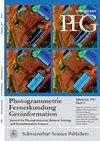分类和空间尺度对作物遥感监督分类的影响
Q Social Sciences
引用次数: 4
摘要
在广阔的地理区域内,高时间重访频率是正确利用卫星对地观测监测农业生产的必要条件。然而,这通常限制了可以使用的空间分辨率。当像素编码的信号来自多个土地用途(混合像素)时,识别对应于特定作物类型的像素的挑战仍然令人生畏,这是作物特定监测的先决条件。自然,空间尺度的概念出现了,但选择一个适当的类图例(分类尺度)的问题不应被忽视。提出了一个解决这些问题的框架,该框架可用于定量定义作物识别的像素大小要求,并评估分类尺度的影响。该框架应用于两个农业景观。结果表明,在给定的分类尺度下,没有唯一的空间分辨率可以同时为所有类别提供最佳的分类结果。以像素大小和纯度为特征的像素群体对不同景观中特定作物的适宜性存在差异,且同一种作物在不同景观之间存在较大差异。在农作物生长监测的背景下,上述框架可以用来绘制选择合适图像的指南,例如合适的像素大小,以及当只对覆盖耕地的像素感兴趣时,选择适合准确作物分类的类图例,作为特定作物监测的先决条件。该框架可用于绘制像素的适用性(或准确性),作为其纯度的函数,以提供分类性能的空间评估本文章由计算机程序翻译,如有差异,请以英文原文为准。
Impact of Categorical and Spatial Scale on Supervised Crop Classification using Remote Sensing
High temporal revisit frequency over vast geographic areas is necessary to properly use satellite earth observation for monitoring agricultural production. However, this often limits the spatial resolution that can be used. The challenge of discriminating pixels that correspond to a particular crop type, a prerequisite for crop specific monitoring remains daunting when the signal encoded in pixels stems from several land uses (mixed pixels). Naturally, the concept of spatial scale arises but the issue of selecting a proper class legend (the categorical scale) should not be neglected. A framework is presented that addresses these issues and that can be used to quantitatively define pixel size requirements for crop identification and to assess the effect of categorical scale. The framework was applied over two agricultural landscapes. It was demonstrated that there was no unique spatial resolution that provided the best classification result for all classes at once at a given categorical scale. The suitability of pixel populations characterized by pixel size and purity differed for identifying specific crops within tested landscapes, and for one crop there were large differences among the landscapes. In the context of agricultural crop growth monitoring the framework described above can be used to draw guidelines for selecting appropriate imagery, e.g. suitable pixel sizes, and for selecting class legends suitable for accurate crop classification when the interest is only on pixels covering arable land as a prerequisite for crop specific monitoring. The framework could be used to plot the suitability (or accuracy) of pixels as a function of their purity to provide a spatial assessment of classification performance
求助全文
通过发布文献求助,成功后即可免费获取论文全文。
去求助
来源期刊

Photogrammetrie Fernerkundung Geoinformation
REMOTE SENSING-IMAGING SCIENCE & PHOTOGRAPHIC TECHNOLOGY
CiteScore
1.36
自引率
0.00%
发文量
0
审稿时长
>12 weeks
 求助内容:
求助内容: 应助结果提醒方式:
应助结果提醒方式:


